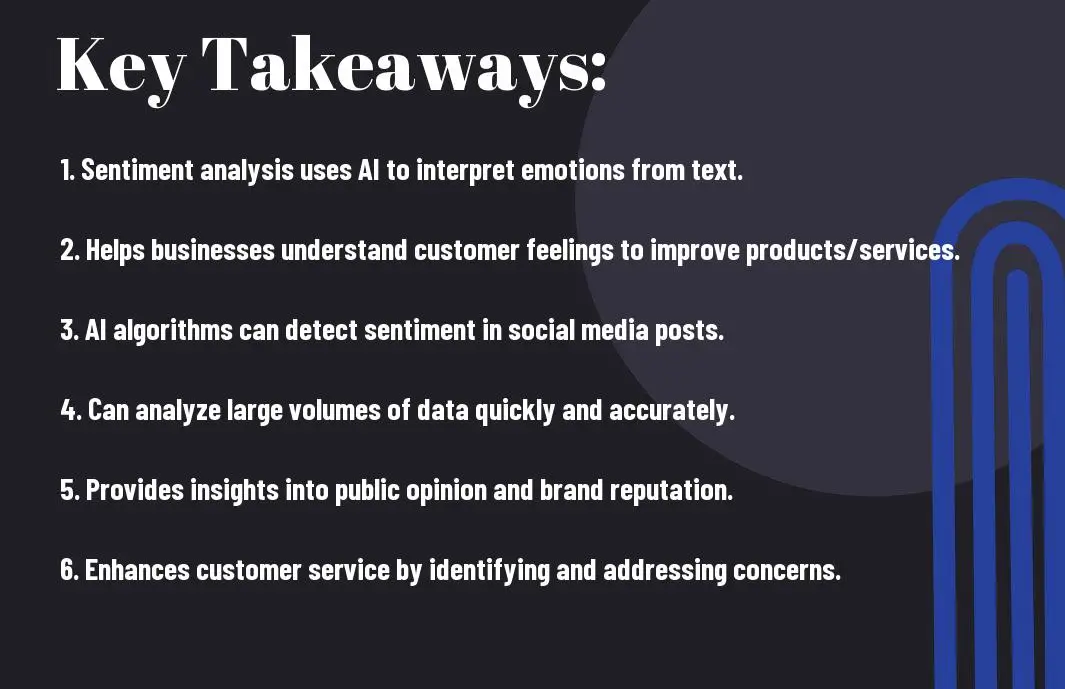Many have marveled at the wonders of AI-driven sentiment analysis, a revolutionary technology that investigates into the intricate realm of human emotions. Through advanced algorithms and machine learning, AI can decipher and analyze sentiments expressed in text, transforming how businesses understand customer feedback, social media trends, and more. Join us as we explore how this cutting-edge technology is unlocking the secrets of emotional intelligence in the digital age.
Key Takeaways:
- Sentiment analysis is a valuable tool: AI-powered sentiment analysis can help businesses understand customer feedback and emotions expressed in text data.
- Emotion recognition is a complex process: AI models are trained to recognize and interpret emotions in text, which involves natural language processing and machine learning algorithms.
- Potential applications are vast: Sentiment analysis can be applied in various sectors such as marketing, customer service, and healthcare to improve decision-making and enhance user experiences.

The Science of Emotions
Before delving into the intricate world of sentiment analysis with AI, it is vital to understand the science behind emotions. Emotions are complex mental states triggered by external stimuli that lead to physiological and psychological changes in an individual. These changes can include an increase in heart rate, sweating, or changes in facial expressions and body language. Emotions play a crucial role in human communication and decision making, influencing our thoughts and behaviors in various situations.
Defining Sentiment Analysis
Analysis of emotions and sentiments, also known as sentiment analysis, is the process of determining the emotional tone behind a series of words, such as positive, negative, or neutral. In AI, sentiment analysis involves using natural language processing (NLP) techniques to understand and interpret human emotions expressed in text data. By analyzing the sentiments behind the words, businesses can gain valuable insights into customer feedback, market trends, and brand reputation.
The Role of AI in Emotion Detection
Sentiment analysis has been revolutionized by the integration of artificial intelligence (AI) technologies. AI algorithms can now analyze vast amounts of textual data at an unprecedented speed and accuracy, enabling businesses to extract valuable insights from customer reviews, social media posts, and other text sources. AI-powered sentiment analysis tools can categorize sentiments, identify trends, and even suggest appropriate responses, allowing companies to make informed decisions based on customer feedback and market sentiments.
Role AI plays a crucial role in emotion detection by providing businesses with the tools to analyze and understand customer sentiments on a large scale. By leveraging AI technologies, companies can gain a competitive edge by responding to customer feedback promptly, improving products and services, and building stronger relationships with their target audience.
How Sentiment Analysis Works
Now, let’s explore into how sentiment analysis works with the help of AI. It involves a combination of Natural Language Processing (NLP) fundamentals, machine learning algorithms for sentiment analysis, text preprocessing, and feature extraction.
Fundamentals: Natural Language Processing (NLP) Fundamentals
Fundamentals of NLP play a crucial role in sentiment analysis. NLP focuses on the interaction between computers and humans through natural language. This involves understanding, interpreting, and generating human language in a valuable way.
Fundamentals: Machine Learning Algorithms for Sentiment Analysis
Fundamentals of machine learning algorithms, such as supervised learning models like Support Vector Machines (SVM) and Naive Bayes, are commonly used for sentiment analysis. These algorithms learn from labeled training data to classify text into positive, negative, or neutral sentiments.
Processing: Machine learning algorithms for sentiment analysis leverage labeled data to train models to classify text sentiment accurately. These models can then be applied to analyze new, unseen text and predict sentiment with high accuracy.
Text Preprocessing and Feature Extraction
Text preprocessing involves cleaning and preparing text data for analysis. This includes removing special characters, stop words, and transforming text into a consistent format. Feature extraction helps in representing text data in a numerical format that machine learning algorithms can understand and process.
Works: Text preprocessing and feature extraction are vital steps in sentiment analysis to ensure the data is structured and relevant for accurate sentiment classification. These processes help in capturing the essence of the text and enable machine learning models to make informed sentiment predictions.
Unlocking emotions through sentiment analysis can provide valuable insights for businesses to understand customer feedback, social media sentiment, and market trends. However, it’s vital to handle sensitive data responsibly and ensure data privacy and security measures are in place. Implementing sentiment analysis with AI can lead to enhanced decision-making, personalized customer experiences, and improved overall business performance.

Applications of Sentiment Analysis
Customer Feedback and Opinion Mining
Many businesses use sentiment analysis to gain valuable insights from customer feedback and opinions. Opinion mining helps organizations track and analyze customer sentiments towards their products, services, and overall brand reputation. By understanding customer emotions and opinions, companies can make informed decisions to improve customer satisfaction and loyalty.
Social Media Monitoring and Brand Reputation
For businesses, maintaining a positive brand reputation is crucial in today’s digital age. Social media monitoring tools powered by sentiment analysis enable companies to For track mentions, comments, and conversations about their brand in real-time. For instance, if a negative sentiment is detected, companies can swiftly address issues and prevent potential reputation damage.
Healthcare and Mental Health Analysis
Any healthcare providers are leveraging sentiment analysis to analyze patient feedback and monitor mental health trends. Analysis of patient reviews and social media discussions can provide valuable insights into patient experiences, allowing healthcare organizations to improve services and offer better support for mental health issues.
Challenges in Sentiment Analysis
Handling Sarcasm and Irony
To accurately analyze sentiment, one of the biggest challenges is handling sarcasm and irony. These linguistic devices are used to convey the opposite of what is actually said, making it difficult for AI to interpret the true sentiment behind the words.
Dealing with Ambiguity and Context
To ensure accurate sentiment analysis, AI systems must be able to deal with ambiguity and context. Words can have multiple meanings depending on the context in which they are used, and understanding the nuances of language is crucial for accurate sentiment analysis.
On top of that, cultural differences can also impact the interpretation of language, making it important for AI to consider the cultural context in which the text is written.
Overcoming Language and Cultural Barriers
A significant challenge in sentiment analysis is overcoming language and cultural barriers. Languages vary greatly in terms of structure, syntax, and sentiment expression, making it challenging for AI to accurately analyze sentiment in different languages.
Sentiment analysis models must be trained on a diverse range of languages and cultural nuances to ensure accurate interpretation of sentiment across different linguistic and cultural backgrounds.
Understanding the complexities of language and culture is crucial for AI systems to overcome these barriers and provide accurate sentiment analysis results.
AI-Powered Sentiment Analysis Tools
Rule-Based Approaches
To understand sentiment analysis, it is necessary to explore the different methodologies used in AI-powered tools. Rule-based approaches rely on a set of manually crafted rules to determine sentiment within text. These rules are based on keywords, linguistic patterns, and grammatical rules that help categorize text as positive, negative, or neutral.
Machine Learning-Based Approaches
Machine learning-based approaches, on the other hand, use algorithms to learn from labeled data and make predictions about the sentiment of new text. These algorithms can analyze vast amounts of text data, identifying complex patterns and nuances that may not be captured by rule-based systems.
Machine learning-based approaches have revolutionized sentiment analysis by allowing systems to adapt and improve over time. They can continuously learn from new data, enhancing their accuracy and effectiveness in understanding and analyzing sentiment in text.
Hybrid Approaches
An emerging trend in sentiment analysis tools is the use of hybrid approaches, which combine the strengths of both rule-based and machine learning techniques. By integrating rule-based heuristics with machine learning algorithms, these tools can achieve a more comprehensive and accurate analysis of sentiment in text.
Another advantage of hybrid approaches is their ability to handle diverse types of texts and languages, making them versatile tools for sentiment analysis across various domains and contexts.
Real-World Examples and Success Stories
Sentiment Analysis in Customer Service
An vital application of sentiment analysis is in customer service. By analyzing customer feedback, companies can gain valuable insights into customer satisfaction levels, identify areas for improvement, and address issues promptly. Unlike traditional methods that rely on manual review of feedback, AI-powered sentiment analysis tools can process large volumes of data quickly and accurately.
Sentiment Analysis in Marketing and Advertising
Sentiment analysis plays a crucial role in marketing and advertising by helping businesses understand the emotions and opinions of consumers towards their products and campaigns. With sentiment analysis, companies can track brand sentiment, assess the impact of marketing strategies, and tailor their messaging to better resonate with their target audience.
With sentiment analysis tools, marketing teams can analyze social media trends, monitor online reviews, and measure the success of their advertising campaigns in real-time. By leveraging AI algorithms to interpret and categorize sentiment, businesses can make data-driven decisions to enhance their marketing efforts.
Sentiment Analysis in Healthcare and Research
Any field that involves understanding human emotions and behaviors can benefit from sentiment analysis, including healthcare and research. In healthcare, sentiment analysis can be used to analyze patient feedback, assess satisfaction levels, and improve the overall quality of care provided.
Healthcare providers can use sentiment analysis to identify trends in patient sentiments, detect potential issues early on, and personalize treatment plans based on emotional cues. By incorporating sentiment analysis into research studies, researchers can gain deeper insights into patient experiences, mental health, and treatment outcomes.
Conclusion
Drawing together the power of artificial intelligence and sentiment analysis has opened up new opportunities for understanding human emotions in a data-driven way. With AI algorithms becoming more sophisticated, we are able to uncover valuable insights from vast amounts of data, helping businesses to make more informed decisions and enhance customer experiences.
As we continue to unlock emotions through sentiment analysis with AI, it is important to remember the ethical considerations and biases that may arise. By approaching this technology with care and responsibility, we can harness its potential to create positive impacts in various industries and ultimately improve the way we connect with one another.
FAQ
Q: What is sentiment analysis?
A: Sentiment analysis is a technique used to determine the emotional tone behind a piece of text, such as positive, negative, or neutral feelings. It uses natural language processing and machine learning algorithms to analyze and classify emotions.
Q: How does AI help in sentiment analysis?
A: AI plays a crucial role in sentiment analysis by automating the process of analyzing large amounts of text data quickly and efficiently. Machine learning algorithms are trained on vast datasets to recognize patterns in language and sentiment, making it possible to accurately classify emotions in real-time.
Q: What are the practical applications of sentiment analysis with AI?
A: Sentiment analysis with AI has a wide range of practical applications, including brand monitoring, customer feedback analysis, social media monitoring, market research, and reputation management. By understanding the emotions behind text data, businesses can make more informed decisions and better serve their customers.




